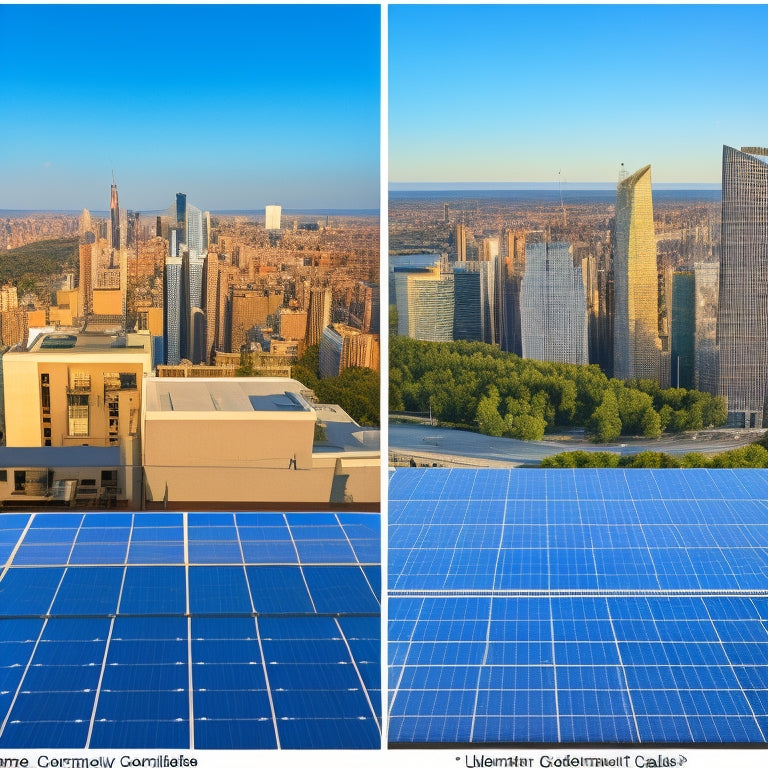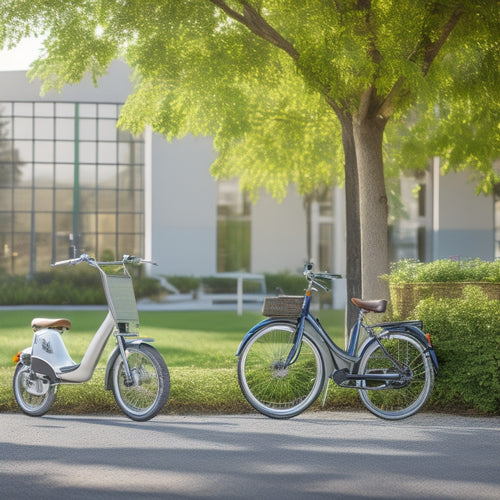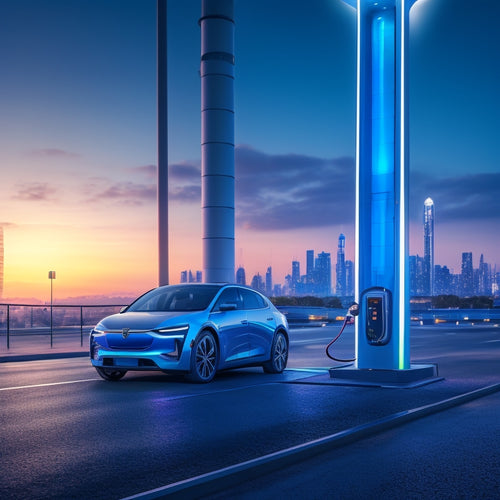
Compare Residential Solar Panel Efficiency Ratings Online
Share
When comparing residential solar panel efficiency ratings online, you'll encounter various options with unique features and benefits. Monocrystalline panels boast high-efficiency ratings, surpassing 20%, while polycrystalline panels offer energy conversion rates ranging from 12% to 17%. Thin-film panels provide a cost-effective solution with average efficiencies between 7-14%. Understanding the factors affecting efficiency ratings, such as climate, angle optimization, and inverter quality, is essential for making informed investment decisions. As you explore the complexities of solar panel efficiency, you'll uncover the nuances of each type, leading you closer to finding the perfect fit for your residential needs.
Key Takeaways
• Compare efficiency ratings of top brands like SunPower, Panasonic, and Tesla, which often exceed 20% efficiency.
• Consider factors affecting efficiency, including climate, angle optimization, shading, inverter efficiency, and panel quality.
• Monocrystalline panels offer high-efficiency cells, maximizing energy production, while polycrystalline panels have lower efficiency ratings.
• Thin-film solar panels provide a cost-effective option with average efficiency of 7-14%, suitable for unique installation requirements.
• Real-world efficiency may differ from lab results, so consider both when making an informed investment decision.
Understanding Solar Panel Efficiency
When you invest in a solar panel system, you want to maximize the amount of electrical energy you can generate from sunlight, which is where solar panel efficiency comes in. Basically, it's a measure of how well your solar panels convert sunlight into usable electricity. A higher efficiency rating means more power per hour of sunlight.
To boost efficiency, manufacturers focus on optimizing Solar Panel Design. This includes using high-quality materials, advanced manufacturing techniques, and innovative technologies. For instance, some panels feature a unique cell structure that minimizes energy loss. Others incorporate reflective coatings to trap more sunlight. These design enhancements enable your system to generate more electricity per unit area, reducing Energy Consumption from the grid.
As a homeowner, understanding solar panel efficiency is important to make informed decisions about your renewable energy investment. By grasping the fundamentals of efficiency, you'll be better equipped to compare different products, assess their performance, and select the best fit for your energy needs.
Factors Affecting Efficiency Ratings
Several factors influence the efficiency ratings of your solar panels, and understanding these factors is essential to optimizing your system's performance. You need to take into account the climate impact on your solar panels, as extreme temperatures, humidity, and weather conditions can affect their efficiency. Additionally, the angle of your solar panels, or angle optimization, plays a vital role in maximizing energy production.
| Factors | Description | Impact on Efficiency |
|---|---|---|
| Climate | Temperature, humidity, weather conditions | 5-10% |
| Angle Optimization | Tilt, orientation, and installation angle | 10-15% |
| Shading | Obstructions, trees, buildings, and other obstacles | 5-10% |
| Inverter Efficiency | Quality and type of inverter used | 5-10% |
| Panel Quality | Type, material, and quality of solar panels | 5-15% |
Understanding these factors will help you select the right solar panels for your specific climate and optimize their installation for maximum energy production. By taking these factors into account, you can ensure your solar panels operate at peak efficiency, providing you with the power you need.
Top Brands and Their Ratings
You'll find that top-tier solar panel brands like SunPower, Panasonic, and Tesla consistently deliver high-efficiency ratings, often exceeding 20% efficiency. These industry leaders have earned a reputation for producing high-quality solar panels that provide exceptional energy output. Their commitment to innovation and quality control has fostered strong brand loyalty among customers.
When evaluating top brands, it's important to take into account warranty options. Reputable manufacturers typically offer thorough warranties that cover defects, performance, and workmanship. For instance, SunPower's warranty covers their solar panels for 25 years, while Panasonic's warranty lasts for 25 years as well. Tesla, on the other hand, offers an 8-year warranty on their solar panels.
When choosing a solar panel brand, it's crucial to weigh the benefits of each manufacturer's warranty options. By doing so, you'll be better equipped to make an informed decision that meets your energy needs and budget.
Comparing Monocrystalline Panels
When comparing monocrystalline solar panels, you'll notice that high-efficiency cells play a significant role in their performance. These cells are designed to maximize energy production, and manufacturers have developed advanced manufacturing processes to achieve this.
High Efficiency Cells
High-efficiency cells, typically found in monocrystalline solar panels, boast higher power output per unit area, making them an attractive option for homeowners with limited roof space. These cells are designed to maximize energy density, allowing you to generate more power from a smaller area. This is achieved through advanced cell design, which optimizes the arrangement of photovoltaic cells to minimize energy loss and maximize energy gain.
As a result, high-efficiency cells can produce up to 20% more energy per unit area than standard cells. This means you can generate more power from a smaller system, making them ideal for homes with limited roof space or those looking to maximize their energy output. When comparing monocrystalline panels, look for high-efficiency cells with advanced cell design to make certain you're getting the most energy density from your system.
Advanced Manufacturing Process
Your search for high-efficiency cells leads you to explore the advanced manufacturing process that sets top-performing monocrystalline panels apart from their competitors.
To achieve exceptional efficiency, top manufacturers employ cutting-edge robotics integration in their production lines. This integration enables precise control over the fabrication process, minimizing defects and ensuring consistency across the entire production run.
Quality control is another vital aspect of advanced manufacturing. Stringent quality control measures are implemented at every stage, from ingot production to module assembly. This guarantees that every cell meets the manufacturer's high standards, resulting in higher power output and increased reliability.
Moreover, advanced manufacturing processes allow for the use of high-purity silicon, further enhancing the panel's efficiency. By leveraging these advanced manufacturing techniques, top-tier manufacturers can produce monocrystalline panels with efficiencies exceeding 22%.
As you compare residential solar panel efficiency ratings online, look for manufacturers that invest in advanced manufacturing processes to reap the benefits of high-efficiency cells.
Polycrystalline Panels Efficiency Compared
When exploring polycrystalline panels, you'll want to analyze their energy conversion rate, which affects how efficiently they harness sunlight.
You'll also need to assess their heat tolerance limits, as high temperatures can impact their performance.
Energy Conversion Rate
When evaluating polycrystalline solar panels, it's important to note that their energy conversion rate, or efficiency, varies greatly between brands and models. This efficiency is measured by the amount of energy harnessed from the sun and converted into electrical energy. The conversion formula is typically expressed as a percentage, with higher percentages indicating higher efficiency.
For polycrystalline panels, you can expect efficiencies ranging from 12% to 17%. This means that for every 100 units of sunlight energy absorbed, the panel can convert 12 to 17 units into usable electricity. While this may seem low, it's crucial to keep in mind that even the most efficient panels on the market rarely exceed 22% efficiency.
When evaluating polycrystalline panels, pay attention to the conversion rate, as it directly impacts the amount of power you can generate. A higher efficiency rating means more electricity produced per hour of sunlight, which can have a significant effect on your energy output over time.
Heat Tolerance Limits
High temperatures can greatly impact the efficiency of polycrystalline solar panels, making heat tolerance limits an important factor to take into account when evaluating their performance. When comparing residential solar panel efficiency ratings, it's important to take into account how well these panels can withstand temperature fluctuations. Thermal stress can greatly affect a panel's ability to convert sunlight into electricity, and excessive heat can result in a decrease in efficiency.
Here's a comparison of the heat tolerance limits of four popular polycrystalline solar panel models:
| Model | Temperature Range (°C) | Efficiency Loss (%) |
|---|---|---|
| Panasonic HIT-240 | -40 to 85 | 0.3 |
| Trina Solar TALL-M10 | -40 to 85 | 0.4 |
| Hanwha Q CELLS Q.PEAK-G4.1 | -40 to 85 | 0.35 |
| Canadian Solar CS6X-300P | -40 to 80 | 0.45 |
Each model has its own temperature range and efficiency loss rate. When choosing a solar panel, take into consideration the temperature range of your installation location and the panel's heat tolerance limits to ensure top performance.
Power Output Variance
You'll find that power output variance is a critical factor in evaluating polycrystalline solar panels, with even a slight deviation from the rated output potentially impacting your energy yield. This variance can be attributed to various factors, including voltage fluctuation, which can occur due to changes in temperature, irradiance, or other environmental conditions. Weather patterns, such as partial shading or cloud cover, can also affect the panel's power output.
When comparing polycrystalline panels, it's important to take into account the power output variance to make sure you're getting the most efficient system for your energy needs. A panel with a lower power output variance will provide a more consistent energy yield, even in varying environmental conditions.
Look for panels with a high fill factor, which indicates a more consistent power output. Additionally, consider panels with built-in maximum power point tracking (MPPT) to optimize energy harvesting.
Thin-Film Panels Efficiency Ratings
Thin-film solar panels, which utilize a layer of photovoltaic material only a few micrometers thick, boast an average efficiency rating of around 7-14%. This may seem low compared to other types of solar panels, but thin-film panels have their advantages.
You'll appreciate their flexible design, which allows them to be installed on curved or irregular surfaces, making them ideal for unique roofing configurations. Additionally, thin-film panels offer cost benefits, as they require less material to produce, resulting in lower manufacturing costs. This translates to a more affordable option for homeowners looking to switch to solar power.
When evaluating thin-film panels, consider the trade-off between efficiency and cost. While they may not generate as much power per hour of sunlight, they can provide a more budget-friendly solution for those seeking to reduce their carbon footprint.
As you compare residential solar panel efficiency ratings online, keep in mind that thin-film panels can be a viable option for homeowners with specific installation requirements or budget constraints.
Real-World Efficiency Vs Lab Results
When evaluating residential solar panel efficiency ratings, it is important to differentiate between laboratory test results and real-world performance, as the two often diverge considerably. You might be surprised to find that the efficiency ratings you see advertised may not translate to your rooftop. This difference arises from the fact that laboratory testing conditions are highly controlled, whereas real-world installations face various environmental factors.
| Laboratory Testing Conditions | Real-World Conditions |
|---|---|
| Ideal temperature: 25°C (77°F) | Varying temperatures (hot and cold) |
| Uniform irradiance | Shading, cloud cover, and seasonal changes |
| Clean, flat surface | Dirt, debris, and angular installation |
In reality, your solar panels will be exposed to varying temperatures, shading, and other environmental factors that can impact their efficiency. To get an accurate picture of a solar panel's performance, it's important to take into account both laboratory test results and real-world data. By doing so, you'll be better equipped to make an informed decision when selecting a solar panel system that meets your energy needs.
Making Sense of Efficiency Ratings
To accurately assess a solar panel's performance, you need to comprehend the efficiency ratings that manufacturers provide, which are usually expressed as a percentage. This rating represents the amount of sunlight that's converted into electrical energy.
When evaluating efficiency ratings, it's crucial to have realistic expectations and debunk common myths. Here are a few key takeaways to bear in mind:
-
Rating expectations: A higher efficiency rating doesn't always translate into more power output. Factors like panel size, temperature, and installation quality also impact performance.
-
Efficiency myths: Don't assume that high-efficiency panels are always the best choice. They can be more expensive and may not provide a substantial increase in power output for your specific needs.
-
Real-world performance: Manufacturers often quote lab-based efficiency ratings, which may not reflect real-world performance. Be sure to take into account real-world data and reviews from existing customers when making your decision.
Frequently Asked Questions
Can I Mix and Match Panels From Different Manufacturers?
When mixing and matching panels from different manufacturers, you'll need to verify panel compatibility; however, be aware that this might void manufacturer warranties, so it's important to check compatibility and warranty terms before making a purchase.
How Do I Calculate the Efficiency of My Existing Solar Panel System?
To calculate your existing solar panel system's efficiency, you'll conduct a system audit, tracking performance metrics like energy output and temperature. Then, you'll divide the output by the input to get the efficiency percentage, giving you a clear picture of your system's performance.
What Is the Average Lifespan of a Residential Solar Panel?
You can expect your residential solar panel to last around 25-30 years, with a gradual decline in efficiency due to panel degradation, weather resistance, and other environmental factors, but proper maintenance helps minimize the impact.
Can I Install Solar Panels on a Metal or Asphalt Roof?
As you anchor your solar dreams to your rooftop, remember, you're not just installing panels, you're harnessing power. Yes, you can install solar panels on a metal or asphalt roof, but make sure roof preparation and weather resistance are prioritized to maximize energy harvest.
Do Solar Panels Work During a Power Outage?
You'll be glad to know that solar panels can provide power during a power outage if you have a grid backup system with energy storage, like batteries, allowing you to harness renewable energy even when the grid is down.
Related Posts
-

Charge Your Ride With Renewable Energy Solutions
By immersing yourself in renewable energy sources like solar power, you can greatly diminish your carbon footprint an...
-

What Are the Best Eco-Friendly Rides for Campus?
As you navigate your college campus, you have a wide range of eco-friendly ride options to choose from, including bic...
-

What Does EV Charging Station Installation Cost?
You can anticipate paying between $300 to $1,500 or more for an EV charging station installation, depending on the ty...


